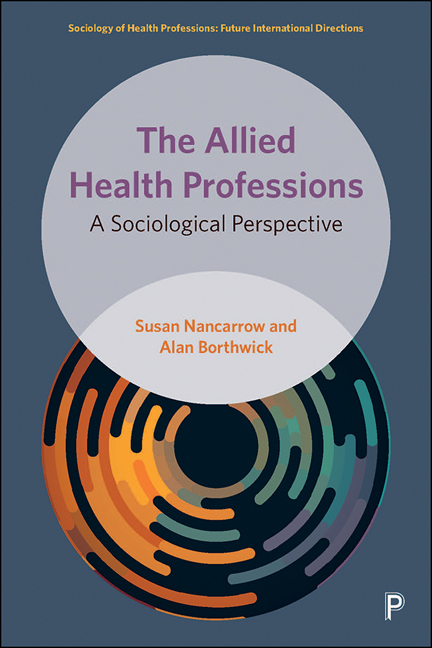Book contents
- Frontmatter
- Contents
- List of abbreviations
- Acknowledgements
- Editors’ overview
- Introduction
- 1 The allied health collective
- 2 Diversity in the allied health professions
- 3 The established allied health professions
- 4 Emerging allied health professions
- 5 The support workforce within the allied health division of labour
- 6 Specialisation in allied health
- 7 Post-professionalism and allied health
- Conclusion
- References
- Index
3 - The established allied health professions
Published online by Cambridge University Press: 05 January 2022
- Frontmatter
- Contents
- List of abbreviations
- Acknowledgements
- Editors’ overview
- Introduction
- 1 The allied health collective
- 2 Diversity in the allied health professions
- 3 The established allied health professions
- 4 Emerging allied health professions
- 5 The support workforce within the allied health division of labour
- 6 Specialisation in allied health
- 7 Post-professionalism and allied health
- Conclusion
- References
- Index
Summary
The largest recognised group of allied health professionals is comprised of the established state-and self-regulated professions. These professions have claimed clear philosophies and sometimes anatomical domains and scopes of practice that differentiate them from each other, and other emerging disciplines. This chapter draws on the examples of optometry and radiography, one of which was established prior to the advent of the era of medical dominance, and the other during it. It thus illustrates the way allied health professions responded to the challenge posed by medicine in defining the new health division of labour that took hold in the early 20th century. It also illustrates the different ways in which these professions later identified with other allied health professions: one as part of the broader collective; the other remaining separate from it (Larkin, 1983; Boyce, 2001, 2006). As was explained in Chapter 2, and should be borne in mind when considering the context of the account that follows, they also serve as useful exemplars of the contrasting gender divide within the allied health professions. Radiography became a primarily female profession, and optometry remained a mainly male profession (though, interestingly, the former remains stable but the latter is becoming more feminised) (Register, 2010; Healy et al, 2015).
Those allied health professions with a long pre-modern history – that is, the groups that emerged prior to the period in which medical dominance became firmly established – experienced medical opposition and resistance in their bid for recognition and state registration during the early to mid-20th century (Larkin, 1981, 1983, 2002). Equally, those that emerged during the period of ascendancy in medical authority experienced the same forces at work. Thus, the neo-Weberian framework is key to understanding the development of these professions, and its various strands become immediately clear as the story unfolds, both the strategies of exclusion, limitation and subordination of the medical profession, and the resistance of the allied health exemplars as they attempted to advance their own professional projects (Saks, 2015, 2017, 2018). As medical hegemony became firmly established, a ‘medico-bureaucratic alliance’ emerged, allowing medicine to assume both social and cultural authority in determining healthcare priorities on behalf of the state (Larkin, 1983).
- Type
- Chapter
- Information
- The Allied Health ProfessionsA Sociological Perspective, pp. 83 - 106Publisher: Bristol University PressPrint publication year: 2021



